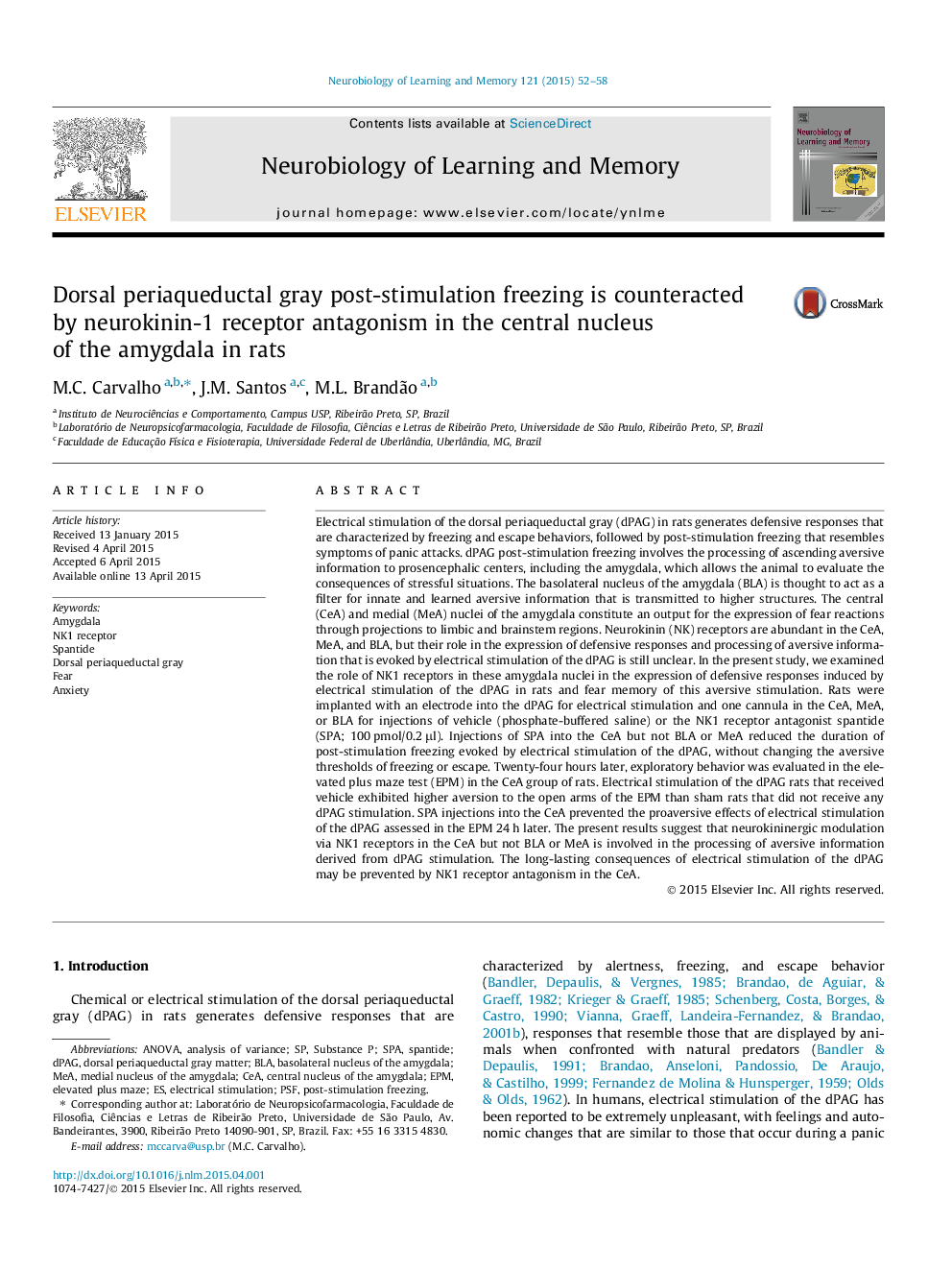| کد مقاله | کد نشریه | سال انتشار | مقاله انگلیسی | نسخه تمام متن |
|---|---|---|---|---|
| 7299476 | 1475154 | 2015 | 7 صفحه PDF | دانلود رایگان |
عنوان انگلیسی مقاله ISI
Dorsal periaqueductal gray post-stimulation freezing is counteracted by neurokinin-1 receptor antagonism in the central nucleus of the amygdala in rats
دانلود مقاله + سفارش ترجمه
دانلود مقاله ISI انگلیسی
رایگان برای ایرانیان
کلمات کلیدی
MEABLAspantideEPMSPAdPAGCeA - CEApsf - PSFAmygdala - آمیگدال، بادامهAnxiety - اضطرابelevated plus maze - بالا به همراه پیچ و خمElectrical stimulation - تحریک الکتریکیanalysis of variance - تحلیل واریانسANOVA - تحلیل واریانس Analysis of varianceFear - ترسdorsal periaqueductal gray - خاکستری پرایکتون پشتی پشتیSubstance P - ماده PDorsal periaqueductal gray matter - ماده ی خاکستری پرایکتوگرافی پشتیcentral nucleus of the amygdala - هسته مرکزی آمیگدالMedial nucleus of the amygdala - هسته مرکزی آمیگدالbasolateral nucleus of the amygdala - هسته نزولی amygdalaNK1 receptor - گیرنده NK1
موضوعات مرتبط
علوم زیستی و بیوفناوری
علم عصب شناسی
علوم اعصاب رفتاری
پیش نمایش صفحه اول مقاله

چکیده انگلیسی
Electrical stimulation of the dorsal periaqueductal gray (dPAG) in rats generates defensive responses that are characterized by freezing and escape behaviors, followed by post-stimulation freezing that resembles symptoms of panic attacks. dPAG post-stimulation freezing involves the processing of ascending aversive information to prosencephalic centers, including the amygdala, which allows the animal to evaluate the consequences of stressful situations. The basolateral nucleus of the amygdala (BLA) is thought to act as a filter for innate and learned aversive information that is transmitted to higher structures. The central (CeA) and medial (MeA) nuclei of the amygdala constitute an output for the expression of fear reactions through projections to limbic and brainstem regions. Neurokinin (NK) receptors are abundant in the CeA, MeA, and BLA, but their role in the expression of defensive responses and processing of aversive information that is evoked by electrical stimulation of the dPAG is still unclear. In the present study, we examined the role of NK1 receptors in these amygdala nuclei in the expression of defensive responses induced by electrical stimulation of the dPAG in rats and fear memory of this aversive stimulation. Rats were implanted with an electrode into the dPAG for electrical stimulation and one cannula in the CeA, MeA, or BLA for injections of vehicle (phosphate-buffered saline) or the NK1 receptor antagonist spantide (SPA; 100 pmol/0.2 μl). Injections of SPA into the CeA but not BLA or MeA reduced the duration of post-stimulation freezing evoked by electrical stimulation of the dPAG, without changing the aversive thresholds of freezing or escape. Twenty-four hours later, exploratory behavior was evaluated in the elevated plus maze test (EPM) in the CeA group of rats. Electrical stimulation of the dPAG rats that received vehicle exhibited higher aversion to the open arms of the EPM than sham rats that did not receive any dPAG stimulation. SPA injections into the CeA prevented the proaversive effects of electrical stimulation of the dPAG assessed in the EPM 24 h later. The present results suggest that neurokininergic modulation via NK1 receptors in the CeA but not BLA or MeA is involved in the processing of aversive information derived from dPAG stimulation. The long-lasting consequences of electrical stimulation of the dPAG may be prevented by NK1 receptor antagonism in the CeA.
ناشر
Database: Elsevier - ScienceDirect (ساینس دایرکت)
Journal: Neurobiology of Learning and Memory - Volume 121, May 2015, Pages 52-58
Journal: Neurobiology of Learning and Memory - Volume 121, May 2015, Pages 52-58
نویسندگان
M.C. Carvalho, J.M. Santos, M.L. Brandão,